Laser-Induced Forward Transfer of Pre-Patterned Solder Paste for High-Aspect-Ratio Deposits
Abstract
1. Introduction
2. Materials and Methods
2.1. Laser-Induced Transfer System
2.2. Material Selection and Preparation
2.2.1. Materials and Physical Properties
2.2.2. Solder Pre-Patterned to Be Transferred
2.3. Characterization Method
3. Results and Discussion
3.1. Description and Analysis of the Transfer Process
3.1.1. Front-Edge Penetration
3.1.2. Interfacial Separation During Gap Expansion
- The laser pulse width is 12 × 10−12 s, yielding a Deborah number , significantly greater than 1, which indicates that the material behaves elastically at the single-pulse time scale;
- During laser scanning across the solder paste pattern, the path duration ranges from 10 to 33 μs, corresponding to , further confirming elastic solid-like behavior and the capacity for elastic energy storage;
- The interval between adjacent laser paths is 7.8 ms, resulting in . This extended interval represents a force-free period during which viscoelastic recovery occurs. It was clearly shown by the analysis of the high-speed image sequences that “step-rebound” angular fluctuations exist, which directly indicate the presence of viscoelastic relaxation. The measured relaxation time () ranged from 0.2 to 3.6 ms during the inter-path gap, allowing sufficient time for material relaxation and resulting in viscous flow behavior.
3.1.3. Separation Followed by Inertial Flight
3.2. Changes in Solder Paste Pattern Morphology During the Transfer Process
- When the AR of PSP > 0.3, the transferred solder paste deposit exhibits a stabilized aspect ratio of approximately 0.7, doubling the initial value of PSP. The height increases to 1.27 times the PSP value, while the diameter decreases to about 0.66 times the original.
- For the intermediate range (0.15 < AR of PSP < 0.3), the aspect ratios of the transferred solder paste deposits range between 0.6 and 0.8, also increasing to over twice the pre-transfer value. The height rises to about 1.6 times, and the diameter contracts to 0.66 times the pre-transfer measurements.
- When the AR of PSP < 0.15, the aspect ratios of the transferred solder blob similarly fall between 0.6 and 0.8. Due to the significantly larger pre-transfer diameter relative to height, rotational effects during transfer cause the aspect ratio to increase by more than fivefold. The height increases to approximately 2.2 times, and the diameter decreases to about 0.49 times the pre-transfer values.
3.3. Energy Threshold Transferable by Solder Paste Globules
3.3.1. Effect of Laser Fluence on the Transfer Process
3.3.2. Energy for Stable Transfer
3.3.3. Relationship Between Solder Volume and the Viable Energy Density Window
4. Conclusions
- The transfer mechanism is governed by laser-induced vaporization pressure, which initiates separation at the solder–glass interface. This separation is then driven progressively along the scan direction by a “micro-chiseling effect,” created by the periodic pressure gradient (∇P) from successive laser paths. The material’s viscoelasticity governs the dynamic response to these forces, as evidenced by the partial angular rebound observed during this tearing process.
- The transfer dynamics were found to be critically dependent on the initial aspect ratio (AR). Low-AR patterns exhibited a distinct bifurcation into bridging and cantilevered sections, whereas high-AR patterns demonstrated a more cohesive, rigid-body-like detachment.
- Compared to the printed solder paste (PSP) patterns, the transferred solder paste deposits (TSDs) exhibited substantially higher aspect ratios, reaching approximately 0.7. Analysis across different solder volumes revealed a positive correlation between the required transfer energy and the solder volume.
- The window’s boundaries were defined by incomplete detachment () and unstable transfer (). The process demonstrates significant process redundancy (Figure 15) within an established stable transfer window of 0.937–1.112 J/cm2. This redundancy—where a wide range of volumes can be transferred at a single energy density, or a single volume is stable across the entire window—ensures superior morphology preservation.
Author Contributions
Funding
Data Availability Statement
Conflicts of Interest
Abbreviations
| LIFT | Laser-induced forward transfer |
| BGA | Ball grid array |
| AR | Aspect ratio |
| SAOS | Small-Amplitude Oscillatory Shear |
| PSP | Printed solder paste pattern |
| TSD | Transferred solder paste deposit |
Appendix A

References
- Chen, Z.; Zhang, J. Challenges and Prospects for Advanced Packaging. Fundam. Res. 2024, 4, 1455–1458. [Google Scholar] [CrossRef] [PubMed]
- Lau, J.H. Recent Advances and New Trends in Flip Chip Technology. J. Electron. Packag. 2016, 138, 030802. [Google Scholar] [CrossRef]
- Wesling, P. The Heterogeneous Integration Roadmap: Enabling Technology for Systems of the Future. In Proceedings of the 2020 Pan Pacific Microelectronics Symposium (Pan Pacific), Big Island, HI, USA, 10–13 February 2020; pp. 1–4. [Google Scholar]
- Sutanto, J.; Anand, S.; Patel, C.; Muthuswamy, J. Novel First-Level Interconnect Techniques for Flip Chip on MEMS Devices. J. Microelectromech. Syst. 2011, 21, 132–144. [Google Scholar] [CrossRef] [PubMed]
- Zhong, Z.W.; Tee, T.Y.; Luan, J. Recent Advances in Wire Bonding, Flip Chip and Lead-free Solder for Advanced Microelectronics Packaging. Microelectron. Int. 2007, 24, 18–26. [Google Scholar] [CrossRef]
- Cho, D.H.; Seo, S.M.; Kim, J.B.; Rajendran, S.H.; Jung, J.P. A Review on the Fabrication and Reliability of Three-Dimensional Integration Technologies for Microelectronic Packaging: Through-Si-via and Solder Bumping Process. Metals 2021, 11, 1664. [Google Scholar] [CrossRef]
- Jang, Y.J.; Sharma, A.; Jung, J.P. Advanced 3D Through-Si-Via and Solder Bumping Technology: A Review. Materials 2023, 16, 7652. [Google Scholar] [CrossRef]
- Lee, M.; Yoo, M.; Cho, J.; Lee, S.; Kim, J.; Lee, C.; Kang, D.; Zwenger, C.; Lanzone, R. Study of Interconnection Process for Fine Pitch Flip Chip. In Proceedings of the 2009 59th Electronic Components and Technology Conference, San Diego, CA, USA, 26–29 May 2009; IEEE: San Diego, CA, USA, 2009; pp. 720–723. [Google Scholar]
- Suhir, E.; Yi, S.; Hwang, J.S.; Ghaffarian, R. Elevated Standoff Heights of Solder Joint Interconnections Can Result in Appreciable Stress and Warpage Relief. J. Microelectron. Electron. Packag. 2019, 16, 13–20. [Google Scholar] [CrossRef]
- Li, S.; Wang, X.; Liao, M.; Li, Z.; Li, Q.; Yan, H.; Liu, A.; Wang, F. Microstructures, Mechanical Properties and Reliability Induced from Size Effect in Sn-Based Solder Joints: Review. J. Mater. Res. Technol. 2025, 35, 5067–5083. [Google Scholar] [CrossRef]
- Gao, C. Reliability Analysis of PoP Stacked Solder Joints under Thermal Cycling Load Based on the Optimal Equivalent Model. Microelectron. J. 2025, 158, 106596. [Google Scholar] [CrossRef]
- Li, L.; Du, X.; Chen, J.; Wu, Y. Thermal Fatigue Failure of Micro-Solder Joints in Electronic Packaging Devices: A Review. Materials 2024, 17, 2365. [Google Scholar] [CrossRef]
- Manessis, D.; Patzelt, R.; Ostmann, A.; Aschenbrenner, R.; Reichl, H. Technical Challenges of Stencil Printing Technology for Ultra Fine Pitch Flip Chip Bumping. Microelectron. Reliab. 2004, 44, 797–803. [Google Scholar] [CrossRef]
- He, X.; Liu, Z.; Cai, J.; Chen, Y.; Tan, L.; Wang, Q. Characterization of Stencil Printing Parameters for Fine Pitch Wafer Bumping. In Proceedings of the 2014 15th International Conference on Electronic Packaging Technology (icept), Chengdu, China, 12–15 August 2014; Bi, K., Tian, Z., Xu, Z., Eds.; IEEE: New York, NY, USA, 2014; pp. 80–85. [Google Scholar]
- Fang, J.; Ran, L.; Huang, W.; Pan, K.; Gong, Y. Prediction of BGA Solder Joint Array Shape Using Improved Perzyna Model and Anand Model. Weld. World 2023, 67, 2765–2778. [Google Scholar] [CrossRef]
- Xian, J.W.; Xu, Y.L.; Stoyanov, S.; Coyle, R.J.; Dunne, F.P.E.; Gourlay, C.M. The Role of Microstructure in the Thermal Fatigue of Solder Joints. Nat. Commun. 2024, 15, 4258. [Google Scholar] [CrossRef] [PubMed]
- Chen, W.-H.; Lin, S.-R.; Chiang, K.-N. Predicting the Liquid Formation for the Solder Joints in Flip Chip Technology. J. Electron. Packag. 2005, 128, 331–338. [Google Scholar] [CrossRef]
- Turkoz, E. Impulsively Induced Jets from Viscoelastic Films for High-Resolution Printing. Phys. Rev. Lett. 2018, 120, 074501. [Google Scholar] [CrossRef]
- Li, S.; Wei, M.; Hao, J.; Tian, S.; Wang, D.; Zhou, J.; Xue, F. Rheological Characterization and Jet Printing Performance of Sn–58Bi Solder Pastes. J. Mater. Sci. Mater. Electron. 2018, 29, 4575–4582. [Google Scholar] [CrossRef]
- Shearer, C. High Aspect Ratio Printing of Sintering Pastes Using Layered Stencils. In Proceedings of the 2016 6th Electronic System-Integration Technology Conference (estc), Grenoble, France, 13–15 September 2016; IEEE: New York, NY, USA, 2016. [Google Scholar]
- Huei, Y.L.; Ting, L.Y.; Hui, C.K.; Kumar, B.S.; Li-San, C.; Fritzsche; Sebastian. Solder Paste Transfer Via Pattern Tape Technology. In Proceedings of the 2020 IEEE 22nd Electronics Packaging Technology Conference (EPTC), Singapore, 2–4 December 2020; pp. 297–301. [Google Scholar]
- Rusdi, M.S.; Abdullah, M.Z.; Chellvarajoo, S.; Abdul Aziz, M.S.; Abdullah, M.K.; Rethinasamy, P.; Veerasamy, S.; Santhanasamy, D.G. Stencil Printing Process Performance on Various Aperture Size and Optimization for Lead-Free Solder Paste. Int. J. Adv. Manuf. Technol. 2019, 102, 3369–3379. [Google Scholar] [CrossRef]
- Nomura, K.; Horii, Y.; Koshi, T.; Yoshida, M.; Ushijima, H.; Matsuo, H.; Ouchida, T.; Kotsubo, Y.; Kurata, Y. Fine Pattern Formation with Solder Paste Using Screen Printing with Stainless Steel Mesh-Cut Screen Mask. J. Micromech. Microeng. 2020, 30, 115023. [Google Scholar] [CrossRef]
- Asghar, R.; Rehman, F.; Aman, A.; Iqbal, K.; Nawaz, A.A. Defect Minimization and Process Improvement in SMT Lead-Free Solder Paste Printing: A Comparative Study. Solder. Surf. Mt. Technol. 2019, 32, 1–9. [Google Scholar] [CrossRef]
- Mohammadhosseinzadeh, M.; Kim, H.; Ghorbani-Menghari, H.; Park, J.; Kang, N.; Jung, M.K.; Na, S.R.; Kim, J.H. Effect of Warpage Pattern of Printed Circuit Board on Solder Paste Volume in the Stencil Printing Process. J. Manuf. Sci. Eng. 2025, 147, 071001. [Google Scholar] [CrossRef]
- Makrygianni, M.; Zacharatos, F.; Andritsos, K.; Theodorakos, I.; Reppas, D.; Oikonomidis, N.; Spandonidis, C.; Zergioti, I. Eco-Friendly Lead-Free Solder Paste Printing via Laser-Induced Forward Transfer for the Assembly of Ultra-Fine Pitch Electronic Components. Materials 2021, 14, 3353. [Google Scholar] [CrossRef]
- Shan, Y.; Zhang, X.; Li, H.; Zhan, Z. Single-Step Printing of High-Resolution, High-Aspect Ratio Silver Lines through Laser-Induced Forward Transfer. Opt. Laser Technol. 2021, 133, 106514. [Google Scholar] [CrossRef]
- Shan, Y.; Zhang, X.; Chen, G.; Li, H. Laser Direct Printing of Solder Paste. AIP Adv. 2019, 9, 125306. [Google Scholar] [CrossRef]
- Munoz-Martin, D.; Brasz, C.F.; Chen, Y.; Morales, M.; Arnold, C.B.; Molpeceres, C. Laser-Induced Forward Transfer of High-Viscosity Silver Pastes. Appl. Surf. Sci. 2016, 366, 389–396. [Google Scholar] [CrossRef]
- Fernández-Pradas, J.M.; Serra, P. Laser-Induced Forward Transfer: A Method for Printing Functional Inks. Crystals 2020, 10, 651. [Google Scholar] [CrossRef]
- Zhang, Y.; He, X.; Tian, C.; Yu, Y.; Shu, Z.; Yu, G.; Li, S. Elucidating the Transfer Dynamics of High-Viscosity Silver Paste for Laser-Induced Forward Transfer of Continuous Line. Opt. Lasers Eng. 2024, 181, 108427. [Google Scholar] [CrossRef]
- Zhang, Y.; Liang, C.; Tian, C.; He, X.; Yu, G.; Li, S. Effects of Thickness-Gap Ratio on Droplet Morphology and Transfer Mechanism for Laser Induced Silver Nanopaste. Appl. Surf. Sci. 2025, 686, 162188. [Google Scholar] [CrossRef]
- Yu, Y.; Zhang, Y.; Tian, C.; He, X.; Li, S.; Yu, G. Characterization of Grid Lines Formed by Laser-Induced Forward Transfer and Effect of Laser Fluence on the Silver Paste Transformation. Photonics 2023, 10, 717. [Google Scholar] [CrossRef]
- Florian, C.; Serra, P. Printing via Laser-Induced Forward Transfer and the Future of Digital Manufacturing. Materials 2023, 16, 698. [Google Scholar] [CrossRef]
- Levy, A.; Bernstein Toker, G.; Winter, S.; Cohen, S.S.; Ermak, O.; Peled, I.; Kotler, Z.; Gelbstein, Y. Hybrid Structural Electronics Printing by Novel Dry Film Stereolithography and Laser Induced Forward Transfer. Nano Sel. 2021, 2, 979–991. [Google Scholar] [CrossRef]
- Shan, Y.; Zhang, X.; Chen, G.; Li, K. Laser Induced Forward Transfer of High Viscosity Silver Paste on Double Groove Structure. Opt. Laser Technol. 2022, 148, 107795. [Google Scholar] [CrossRef]
- Fujisawa, K.; Yamagata, T.; Fujisawa, N. Liquid Droplet Impingement Erosion on Groove Roughness. Nucl. Eng. Des. 2018, 330, 368–376. [Google Scholar] [CrossRef]
- Kaur, K.S.; Feinaeugle, M.; Banks, D.P.; Ou, J.Y.; Di Pietrantonio, F.; Verona, E.; Sones, C.L.; Eason, R.W. Laser-Induced Forward Transfer of Focussed Ion Beam Pre-Machined Donors. Appl. Surf. Sci. 2011, 257, 6650–6653. [Google Scholar] [CrossRef]
- Moreno-Labella, J.; Candorcio-Simón, R.; Munoz-Martin, D.; Lauzurica, S.; Morales, M.; Molpeceres, C. Blister-Actuated Laser-Induced Forward Transfer (BA-LIFT): Understanding Blister Dynamics for Enhanced Process Control. Opt. Laser Technol. 2025, 182, 112087. [Google Scholar] [CrossRef]
- Towell, G. When to Downsize Solder Paste Powders; Circuit Engineering Association, Inc.: San Francisco, CA, USA, 2024. [Google Scholar]
- Liu, S.; Yan, Y.; Zhou, Y.; Han, B.; Wang, B.; Zhang, D.; Xue, S.; Wang, Z.; Yu, K.; Shi, Y.; et al. Thermal Induced Interface Mechanical Response Analysis of SMT Lead-Free Solder Joint and Its Adaptive Optimization. Micromachines 2022, 13, 908. [Google Scholar] [CrossRef] [PubMed]
- Tian, Y.; Chan, Y.C.; Lai, J.K.L.; Pak, S.T.F. The Effect of Solder Paste Viscosity on Porosity and Mechanical Properties of Surface Mount Solder Joints. IEEE Trans. Comp. Packag. Manufact. Technol. B 1997, 20, 146–151. [Google Scholar] [CrossRef]
- Guo, F.L.; He, B.B.; Niu, X. Analysis of Vapor Pressure and Void Volume Fraction Evolution in Porous Polymers: A Micromechanics Approach. Int. J. Solids Struct. 2015, 66, 133–139. [Google Scholar] [CrossRef]
- Mallik, S.; Chan, E.H.L.; Ekere, N. Nonlinear Viscoelastic Characteristics of Sn-Ag-Cu Solder Pastes Used in Electronics Assembly Applications. J. Mater. Eng. Perform. 2013, 22, 1186–1193. [Google Scholar] [CrossRef]
- Zhu, P.; Li, D.; Yu, X. Surface Elasticity Effect on Plateau–Rayleigh Instability in Soft Solids. Int. J. Mech. Sci. 2025, 305, 110750. [Google Scholar] [CrossRef]
- Pei-Lim, S.; Thum, K.; Mackie, A. Challenges in Fine Feature Solder Paste Printing for SiP Applications. Int. Symp. Microelectron. 2016, 2016, 000245–000249. [Google Scholar] [CrossRef]
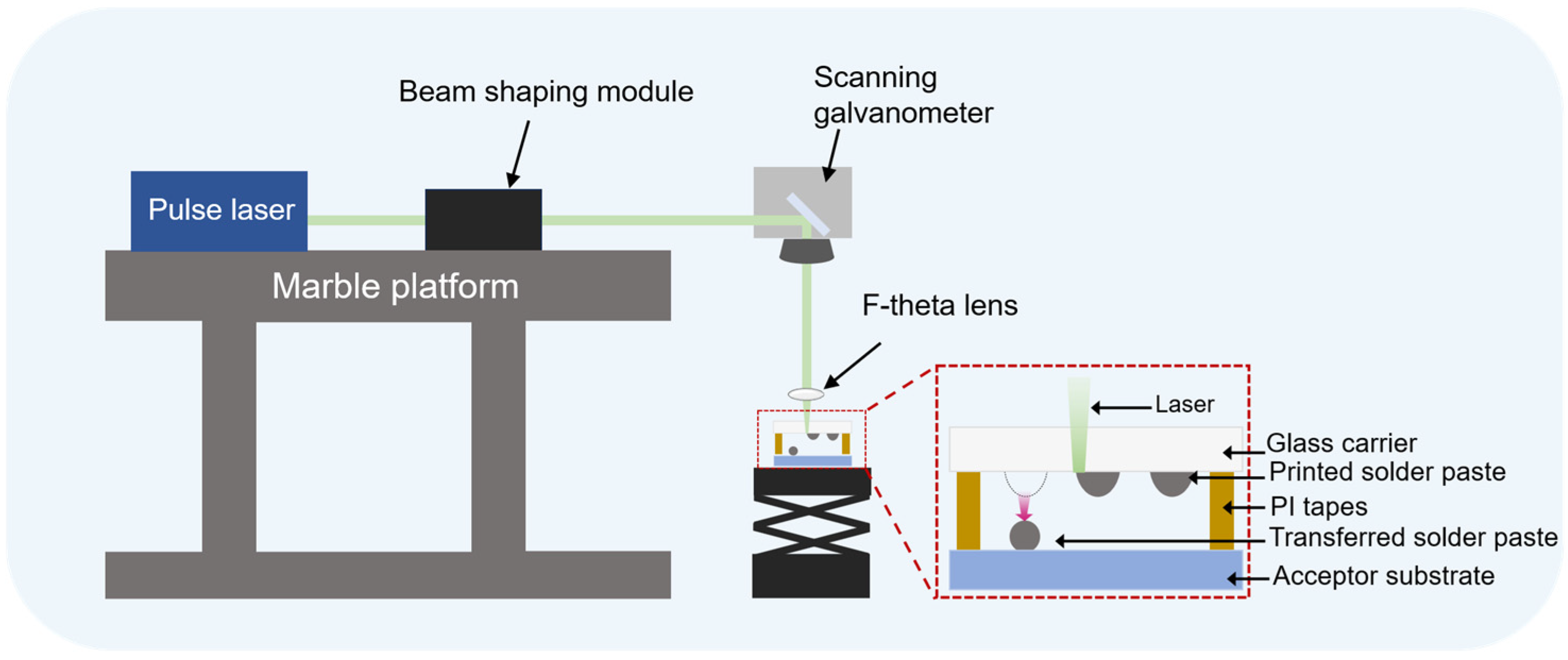
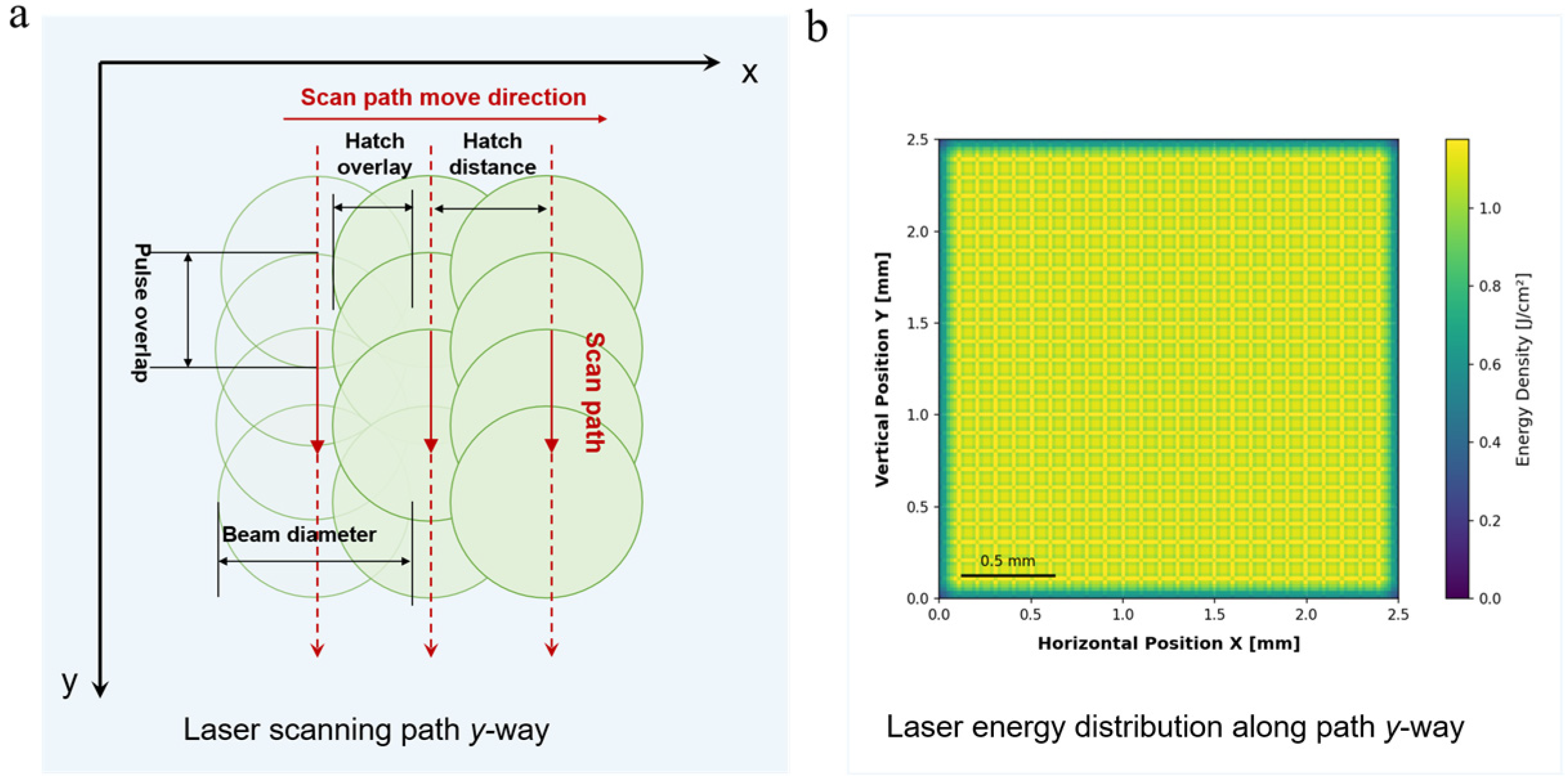


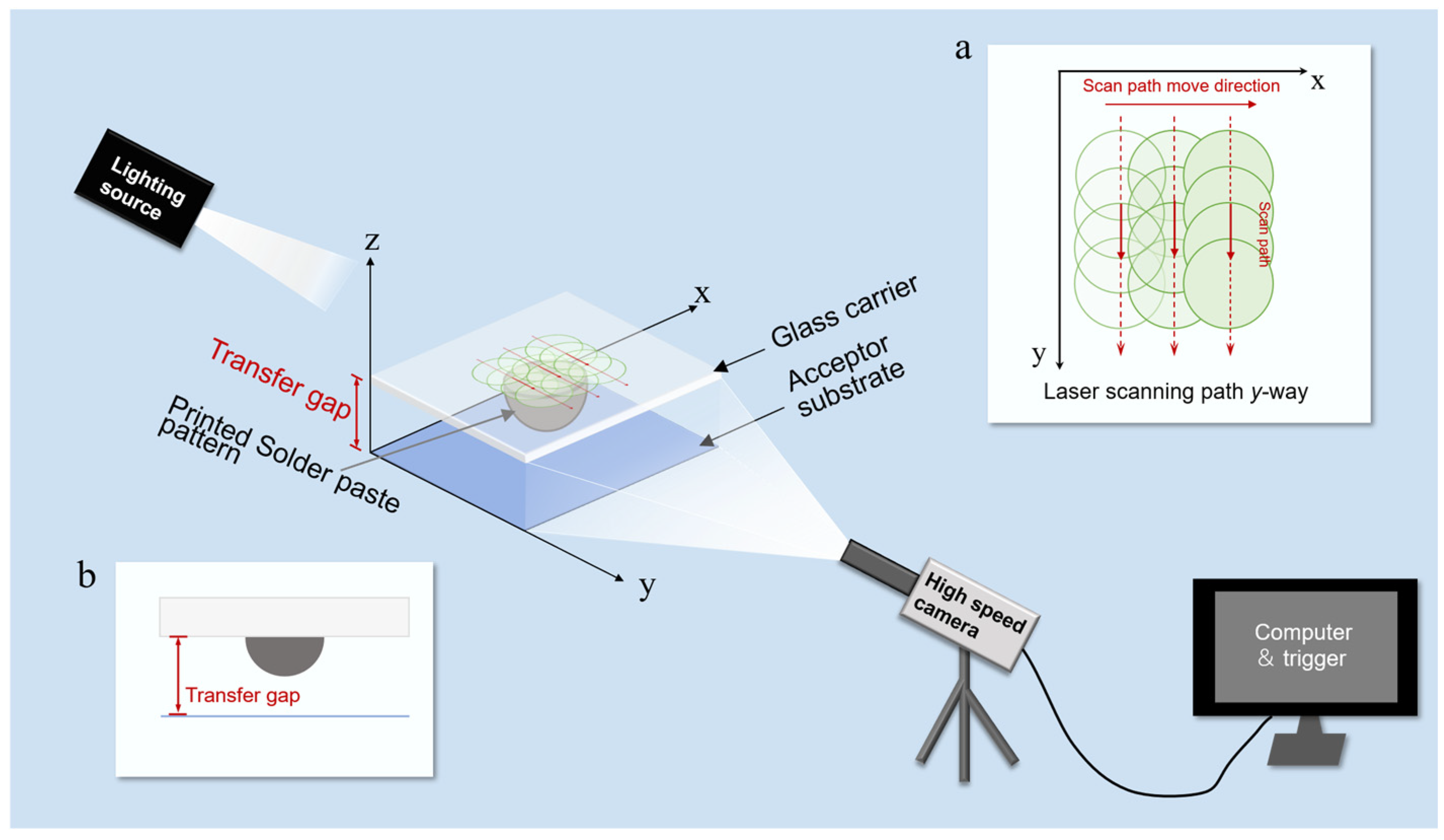




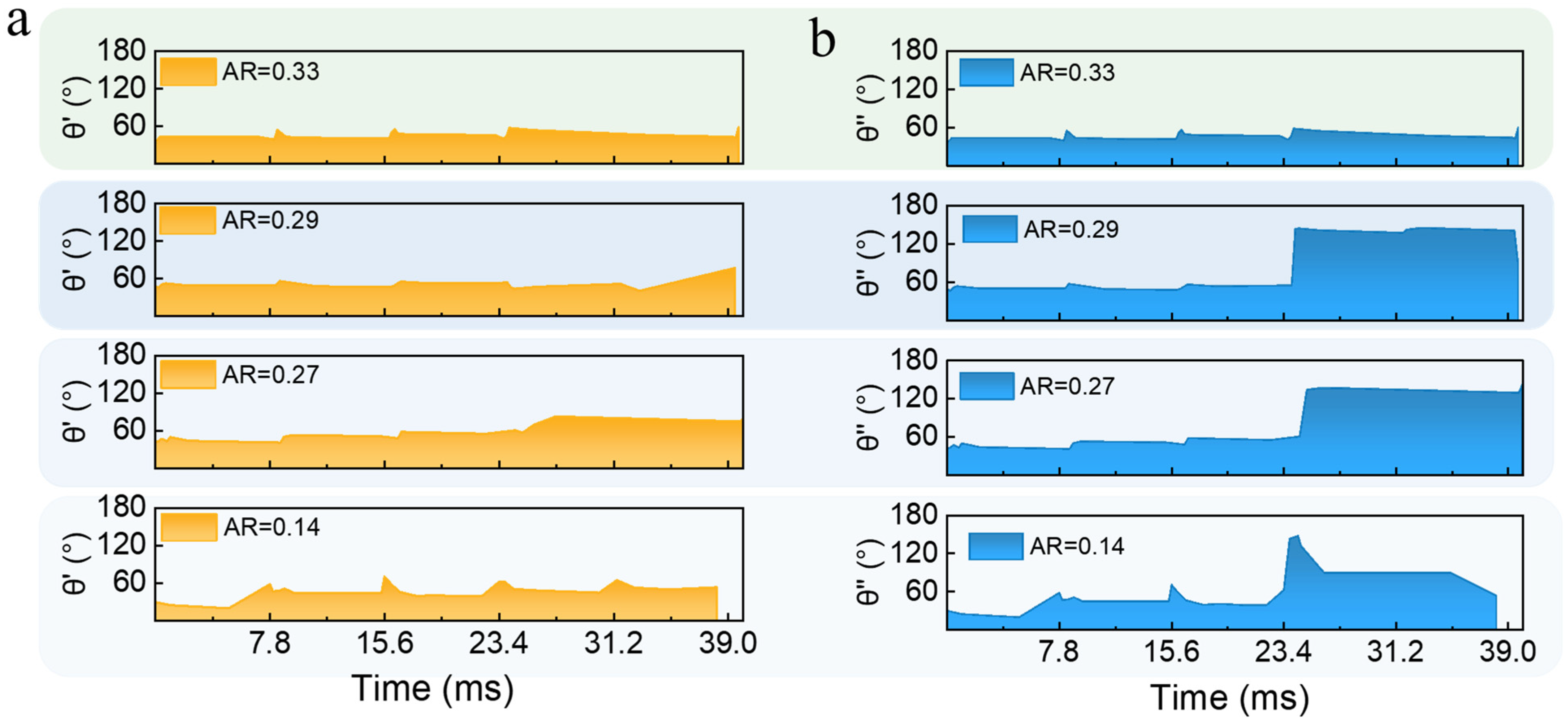

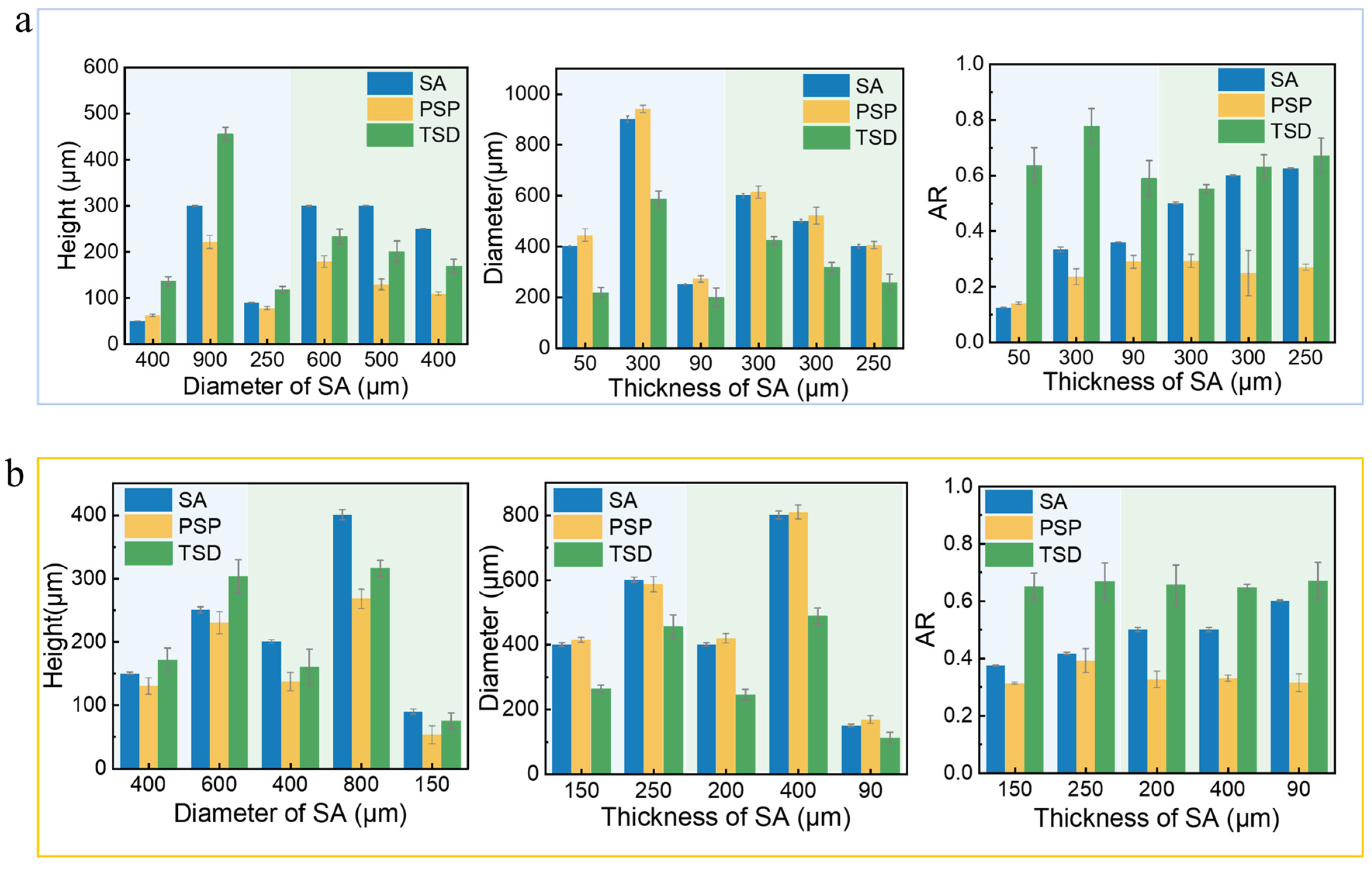


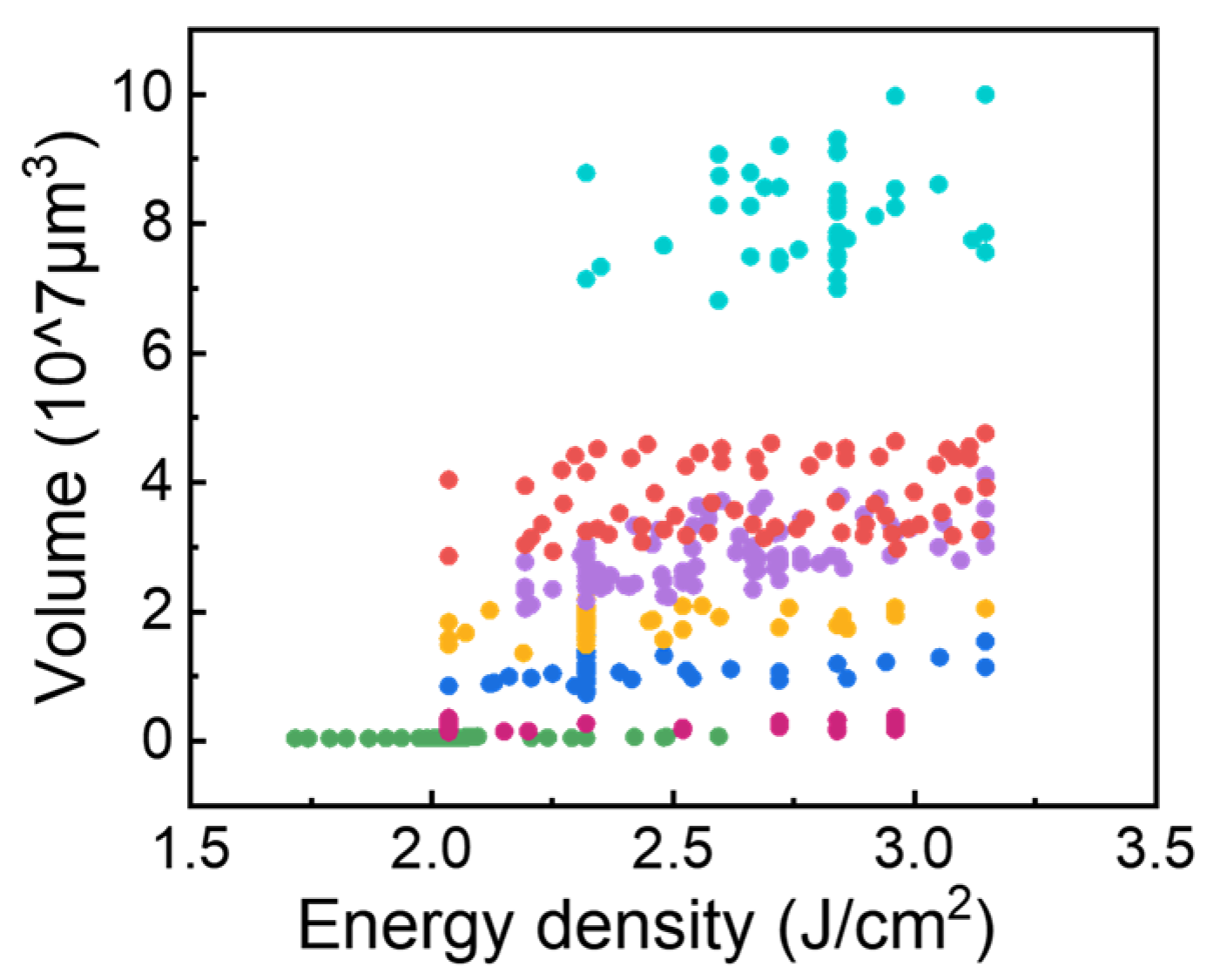
| M705-LFAC60-Type6D-15.0 | |||||
|---|---|---|---|---|---|
| Type | Particle Size | Components | Organic Solvent Content | Viscosity | Melting Point |
| Type6 | 5~15 μm | Sn96.5/Ag3.0/Cu0.5 | 15 ± 1% | 110 ± 20 Pa·s | 217~220 °C |
| Time(ms) | 7.8 | 9.8 | 15.6 | 19.0 | 24.2 | 26.2 |
|---|---|---|---|---|---|---|
| θ′ (°) | 58.6 | 45.0 | 70.9 | 41.2 | 50.5 | 48.4 |
| θ″ (°) | 58.6 | 45.0 | 70.9 | 41.2 | 137.9 | 95.1 |
| image |  |  |  |  |  |  |
| Time(ms) | 7.8 | 15.6 | 15.8 | 23.4 | 33.4 | 39.0 |
|---|---|---|---|---|---|---|
| θ′ (°) | 39.1 | 41.4 | 51.3 | 40.4 | 46.4 | 37.2 |
| θ″ (°) | 39.1 | 41.4 | 51.3 | 40.4 | 50.6 | 43.5 |
| image |  |  |  |  |  |  |
Disclaimer/Publisher’s Note: The statements, opinions and data contained in all publications are solely those of the individual author(s) and contributor(s) and not of MDPI and/or the editor(s). MDPI and/or the editor(s) disclaim responsibility for any injury to people or property resulting from any ideas, methods, instructions or products referred to in the content. |
© 2025 by the authors. Licensee MDPI, Basel, Switzerland. This article is an open access article distributed under the terms and conditions of the Creative Commons Attribution (CC BY) license (https://creativecommons.org/licenses/by/4.0/).
Share and Cite
Liang, C.; Tian, C.; Zhang, Y.; He, X.; Bian, Y.; Dong, B.; Yu, G.; Li, S. Laser-Induced Forward Transfer of Pre-Patterned Solder Paste for High-Aspect-Ratio Deposits. Materials 2025, 18, 5154. https://doi.org/10.3390/ma18225154
Liang C, Tian C, Zhang Y, He X, Bian Y, Dong B, Yu G, Li S. Laser-Induced Forward Transfer of Pre-Patterned Solder Paste for High-Aspect-Ratio Deposits. Materials. 2025; 18(22):5154. https://doi.org/10.3390/ma18225154
Chicago/Turabian StyleLiang, Chaofan, Chongxin Tian, Yanmei Zhang, Xiuli He, Yanhua Bian, Binxin Dong, Gang Yu, and Shaoxia Li. 2025. "Laser-Induced Forward Transfer of Pre-Patterned Solder Paste for High-Aspect-Ratio Deposits" Materials 18, no. 22: 5154. https://doi.org/10.3390/ma18225154
APA StyleLiang, C., Tian, C., Zhang, Y., He, X., Bian, Y., Dong, B., Yu, G., & Li, S. (2025). Laser-Induced Forward Transfer of Pre-Patterned Solder Paste for High-Aspect-Ratio Deposits. Materials, 18(22), 5154. https://doi.org/10.3390/ma18225154








